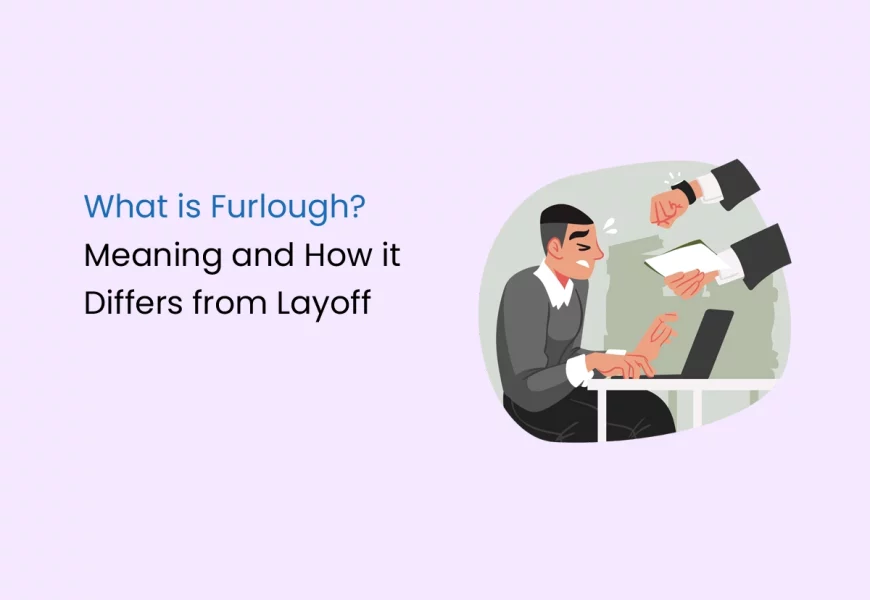Companies facing economic difficulties may have to decide between furloughing or laying off employees. Furlough means a temporary pause in work during which employees keep their jobs but aren’t paid for a specific period. The length of the furlough depends on how long the company needs to reduce costs. During a furlough, employees may have to attend meetings or take training, but they don’t have to work.
This blog will explore furlough, its meaning, length, benefits and how it differs from layoffs.
What is Furlough?
A furlough is a period of mandatory temporary leave of absence provided to an employee due to an organisation’s unique circumstances, such as economic downturn, financial constraints, or restructuring. During the furlough period, the employee is expected to take time off from work or work on a reduced schedule without receiving pay or benefits. However, furloughed employees typically retain their positions and may be called back to work when the organisation’s situation improves. Furloughing does not imply that the employee’s employment will be terminated. Still, it is a cost-saving measure that helps organisations manage their workforce in challenging times.
The reasons an organisation may furlough its employees are as follows:
- Balancing the company’s budget.
- Handling a reduced supply of a basic part for a product.
- Managing staffing for seasonal positions.
- Acclimate to lower demand for a service.
- Adjusting to a decrease in revenue.
- Transitioning to new national economic conditions.
- Ensuring employee health and safety.
- Adapting to global health conditions.
How does Furlogh take Place?
Companies commonly use furloughs when they face financial difficulties or lack of work to pay their employees’ salaries, especially during emergencies or partial organisational shutdowns. This approach allows the employees to maintain their relationship with the company and expect to return to their routine work schedule. However, when a company mandates its employees to work fewer hours or take extended unpaid leaves, it is known as a complete furlough.
Companies may need to reduce their expenses temporarily due to economic challenges. Furloughing employees can be a good short-term solution, especially if the company expects better business prospects soon. Re-staffing with experienced employees who already know the company’s operations and processes can save time and money that would have been spent on recruiting and training new employees.
How Long Does a Furlough Last?
Furloughs are typically temporary, but their duration depends on the company’s needs. Employers usually inform employees in advance about planned furloughs. They may specify their expected length or indicate that they are indefinite. Companies handle furloughs in various ways, such as reducing hours per day, days per week, or weeks per month. Seasonal employees may take extended furloughs that involve several months of leave.
How do Furloughs Work?
Employers determine the duration of furlough based on their circumstances. For example, if a fire damages a retail store, the furlough can be long-term until the store is rebuilt. In contrast, if an employer needs to furlough employees to meet budget requirements, it may be just for a week or so of mandatory unpaid days off work.
Some industries require seasonal furloughs. Vacation cottages and theme parks reduce their operations during the off-season and furlough most employees. In such cases, employees are informed well before the furlough period. They may be eligible for unemployment benefits during their time off. Some employers may also offer furloughed employees the option to use accrued paid time off during the furlough period to help offset the financial impact of unpaid time off.
Examples of Furloughs
Furloughs are common during economic downturns, seasonal shutdowns, and government shutdowns. Companies reduce costs by requiring employees to take unpaid days off, while seasonal furloughs occur when companies shut down for the winter or face temporary shortages of materials. Government shutdown furloughs happen when funds are not allocated to pay government employees. In 2018, the US experienced its longest government shutdown, which lasted 35 days and led to hundreds of thousands of federal employees being furloughed.
Furlough Requirements
Furloughs affect nonexempt (hourly) and exempt (salaried) employees differently. Employers can legally impose furloughs on hourly employees, but they must reduce their workload to match the cut in hours. That’s because nonexempt employees must be paid for every hour they work. On the other hand, exempt employees who receive predetermined salaries weekly or monthly cannot usually work during furloughs. They must be paid their full salaries if they do any work, with some exceptions.
Benefits for Furloughing Employees
The benefits for furloughing employees are as follows:
- Cost Reduction and Avoidance of Layoffs: Furloughs enable corporations to reduce staffing costs without resorting to permanent layoffs, which can have significant financial and reputational consequences. By implementing furloughs, companies can retain valuable talent while still achieving cost-saving objectives, thereby preserving their workforce for future business needs.
- Minimised Recruitment and Training Costs: Unlike layoffs, which may require businesses to rehire and train new employees once conditions improve, furloughs allow companies to retain skilled workers without incurring the costs associated with recruitment, onboarding, and training. This saves both time and money for corporations, as they can quickly resume operations with experienced staff once the furlough period ends, avoiding disruptions to productivity and efficiency.
- Preservation of Employee Experience and Development: Furloughed employees retain their connection to the company, preserving years of experience, knowledge, and expertise that would otherwise be lost through layoffs. This continually benefits both the employee and employer, allowing for the retention of institutional knowledge and facilitating a smoother transition to full operations once economic conditions improve.
- Maintained Benefits Coverage for Retired Workers: Retired workers who are furloughed may still be eligible to receive benefits coverage from their employer, such as health insurance, while simultaneously collecting unemployment insurance. This arrangement benefits both the retired employee, who maintains access to crucial benefits, and the employer, who can reduce staffing costs by cutting hours while providing essential support.
- Flexibility and Adaptability in Challenging Times: Furloughs offer corporations flexibility in managing their workforce during economic uncertainty or disruption, allowing them to adjust staffing levels based on fluctuating demand or budgetary constraints. This adaptability enables companies to weather temporary business downturns without resorting to drastic measures such as layoffs, maintaining stability and resilience in the face of adversity.
Disadvantages of Furloughed Employees
The disadvantages of furloughed employees are as follows:
- Risk of Losing Valuable Employees: In operational businesses, top talent is significantly lost as employees may seize the opportunity to update their resumes and explore job opportunities during the furlough period. Employees may consider alternative employment options, even just for a few weeks. If they decide not to return, the business faces the challenge of recruiting and training new staff, potentially losing valuable experience and expertise.
- Loss of Productivity: Upon returning to work after a furlough, employees may experience a period of adjustment, affecting their productivity and efficiency. It may take time to readjust to their roles and responsibilities, resulting in a temporary dip in performance compared to pre-furlough levels.
- Lowered Employee Morale: Reduced staffing levels and working hours can lead to longer delivery times, increased pressure on customer service networks, and diminished customer satisfaction. This can contribute to heightened employee stress, fostering an environment prone to gossip, rumours, and decreased productivity.
- Insurance Coverage Considerations: For businesses providing employer-sponsored health insurance, insurers may have specific requirements regarding employee coverage. Employees who work fewer hours due to furloughs may risk losing their insurance coverage. Keeping insurance brokers informed about furlough plans is advisable to ensure compliance with coverage regulations and address potential employee benefits gaps.
Difference between Furlough and Layoff
When a company needs to make employment changes, it may implement a furlough or a layoff. These terms are often confused, but they have essential differences.
A furlough is a temporary leave of absence for an employee. During a furlough, employees may have their hours reduced or take an unpaid absence. However, they are still considered an employee of the company and may be eligible for certain benefits. The employee is expected to return to work when the furlough period ends, but this is not guaranteed.
A layoff, however, is a permanent end to an employee’s employment. When an employee is laid off, they are no longer an employee of the company. They are not entitled to any pay or benefits. Layoffs can be temporary, but they are typically intended to be permanent.
Furloughs and layoffs have different impacts on employees. While a furlough is temporary, it can still significantly impact an employee’s income and benefits. A layoff, however, is a permanent separation from the company and can have long-term effects on an employee’s career.
Understanding the difference between a furlough and a layoff is essential for employees. A furlough is a temporary leave of absence, while a layoff is a permanent end to employment. Both can significantly impact an employee’s income and benefits, so it’s essential to understand the details of each before making employment decisions.
How to Decide Whether to Furlough or Layoff Employees
The following can help employers to decide whether to furlough or layoff their employees:
- Length of the Downturn: If the downturn is expected to be short-lived and circumstances and the demand for labour are predicted to improve shortly, a furlough might be the appropriate option, as opposed to more extended periods of decline that may warrant layoffs.
- Impact on Company Reputation: Employers must also assess the impact of their decision on the company’s reputation. While a layoff may be viewed negatively, stringing employees along on an extended furlough could hurt public opinion of the business. Striking a balance between financial needs and maintaining goodwill is essential.
- Employee Preferences: Employee preferences should also be considered. Employers with open-door policies should be upfront with their employees about the situation and let them have a say in the decision. This can help maintain a sense of transparency and trust between the businesses and their employees. Employees may appreciate being included in discussions about the situation and allowed to provide input, fostering a sense of trust and loyalty.
- Weigh All Options: Employers must weigh all options before making a decision. Seeking the advice of attorneys, HR managers, benefits administrators, and other personnel may provide valuable insight into what’s necessary to keep the business afloat today and thrive.
Conclusion
Furloughs are a temporary workforce management strategy that some employers use to deal with economic uncertainties while keeping valuable employees. Employers and employees must understand the implications of furloughs to navigate the challenges effectively. Employers can minimise the negative impact of furloughs on their workforce by implementing best practices for communication, support, and planning. At the same time, employees can use the furlough period as an opportunity for personal and professional growth.
Frequently Asked Questions
Do furloughed employees get paid?
Furloughs are temporary layoff periods during which employees don't work and don't get paid but retain their jobs and benefits.
What is the furlough leave in India?
Employees not actively working or receiving regular salary or wages are still employed by the company.
Why would a company furlough instead of layoff?
Companies choose furloughs over layoffs to retain valued employees and avoid the cost and time of hiring new ones in the future.
Is furlough the same as being laid off for unemployment?
Furloughed workers' eligibility for unemployment benefits differs across states. Some states waive job search requirements, while others don't.
Can an employee quit while on a furlough?
Furloughed employees can seek permanent jobs elsewhere, which is a risk for businesses that reduce their workforce this way. Employers may limit temporary work during a furlough depending on the agreement terms.
Is it better to be furloughed or laid off?
Furloughs and layoffs have pros and cons. Furloughed employees may keep benefits and have a chance to return, but prolonged furloughs may lead to layoffs. Laid-off employees start job hunting early, which could lead to a better job faster.














